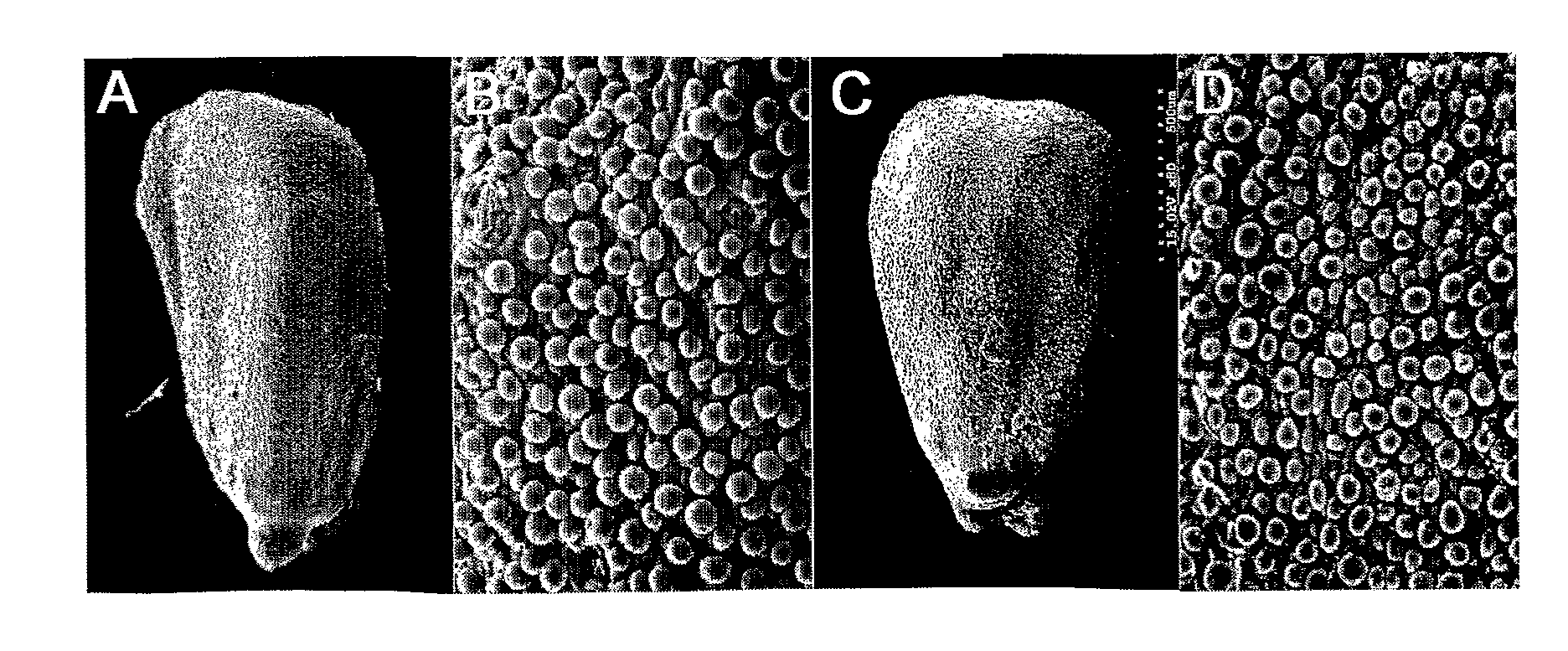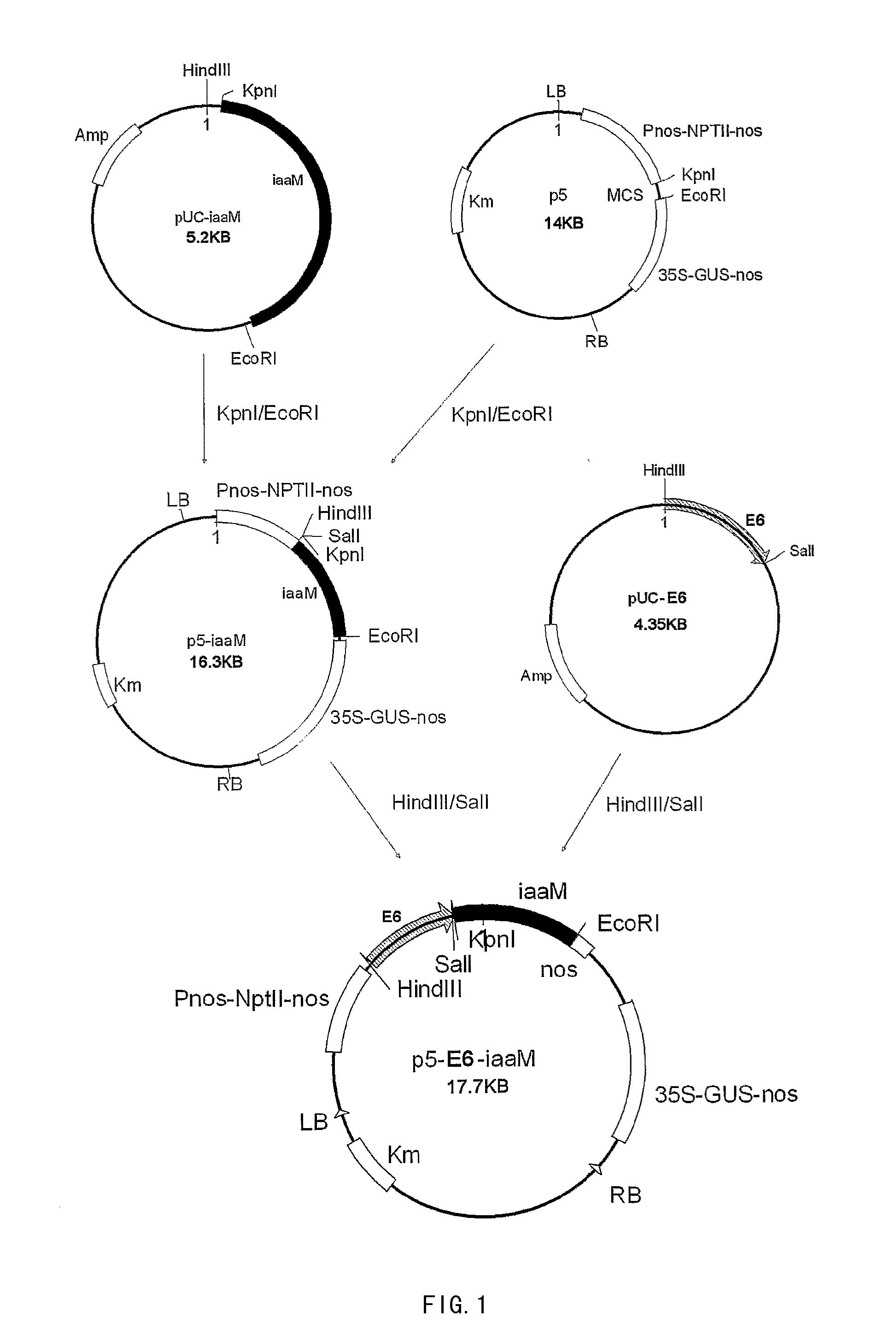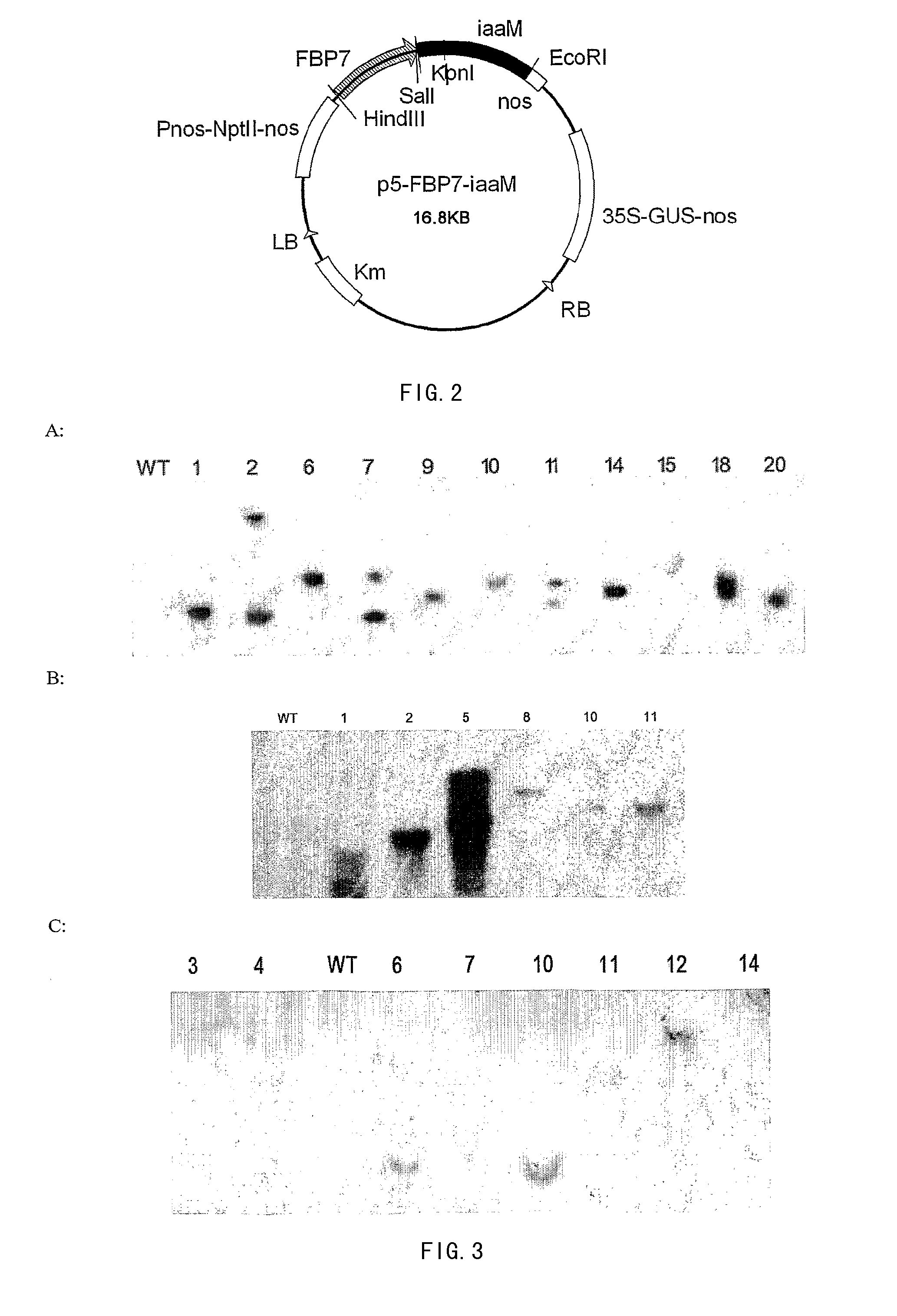Plant Expression Vector Expressing Auxin Synthesis Related Gene and the Use Thereof in Improving Cotton Fiber Trait
a technology of auxin and plant expression, applied in the field of plant expression vectors, can solve the problems of low fiber strength and roughness, low quality of raw cotton, and low competitiveness of raw cotton in the international market, and achieve the effects of improving cotton fiber trait, modulating auxin level, and improving cotton fiber trai
- Summary
- Abstract
- Description
- Claims
- Application Information
AI Technical Summary
Benefits of technology
Problems solved by technology
Method used
Image
Examples
example 1
The Preparation of Cotton Genome
1. Extracting DNA
[0060]0.5-1.0 g of young cotton leaves were selected and quickly ground into powder in liquid nitrogen. Add 3 mL CTAB extract preheated at 65° C. (100 mmol / L Tris-HCl (pH8.0), 20 mmol / L EDTA (pH8.0), 1.5 mol / L NaCl, 2% CTAB (W / V), 4% PVP40 (W / V) and 2% mercaptoethanol (V / V), PVP and mercaptoethanol were added before use), agitate and mix fastly; water bath at 65° C. for 30 mins, then add 1 mL 5 mol / L KAc, ice bath for 20 mins, extract once by using the equal volume of chloroform: isoamyl alcohol (24:1) (centrifugate at 10,000 r / min at 4° C. for 5 mins), take supernatant, add ⅔× volume of −20° C. pre-cooled isopropanol, mix and stand for about 30 mins, pick out flocculent precipitate with a glass rod, rinse several times repeatedly with 75% ethanol, and then rinse once with absolute ethanol, blow-dry, and resuspend in 500 μL, TE. Add 1 μL, RNaseA (10 mg / mL), treat at 37° C. for 1 h. Then, extract respectively once by using phenol (pH8....
example 2
The Preparation of the Nucleotide Sequence Expressing Auxin Synthesis Related Gene and the Plant Expression Vector
1. Obtaining the Specific Promoters
[0067]Design primers (SEQ ID NOs. 1 and 2) according to petunia seed coat-specific promoter FBP7 (GenBank accession number: U90137). Obtain a fragment of about 500 bp from the petunia genome by PCR amplification. The amplified DNA fragment was cloned into pUCm-T (Sangon Biotech (Shanghai) Co., Ltd.). The sequencing analysis showed that it was petunia FBP7 specific promoter; see SEQ ID NO. 3. The clone vector was designated as pUC-FBP7.
[0068]Design E6 specific primers (SEQ ID NOs. 4 and 5) according to cotton fiber-specific promoter E6. Obtain a fragment of about 1.4 kb from the Gossypium hirsutum genome by amplification. The amplified DNA fragment was cloned into pUCm-T (Sangon Biotech (Shanghai) Co., Ltd.). The sequencing analysis showed that it was Gossypium hirsutum E6 fiber-specific promoter; see SEQ ID NO. 6. The clone vector was d...
example 3
The Preparation of Transformants and Transgenic Plants
[0073]1. The Constructed Plant Expression Vector Plasmid was Introduced into Agrobacterium LBA4404 by the Electric Shock Method
[0074]With reference to Bio-RAD Micropulser user manual, the vector above was introduced into Agrobacterium LBA4404 through electric shock.
2. Integrating the Vector Specifically Expressing the Plant Hormone Synthesis Related Gene into the Cotton Genome
[0075]Perform the genetic transformation of cotton by Agrobacterium tumefaciens mediated method.
TABLE 1culture medium for genetic transformation of cottonmediated by Agrobacterium tumefaciensMedium NameComponentsBasic medium.MSB (MS inorganic salts + B5 organic)Medium for seed½ MSB + 30 g / L glucose + 7.5 g / L agarose, pH 6.5germinationCallus inductionMSB + 0.5 mg / L IAA + 0.1 mg / L Kt + 30 g / L glucose + 2.0 g / LmediumGelrite, pH 5.8.Embryogenic callusMSB + 1.9 g / L KNO3 + 30 g / L glucose + 2.0 g / L Gelrite,induction mediumpH 5.8Co-culture mediumMSB + 1.9 g / L KNO3 +...
PUM
| Property | Measurement | Unit |
|---|---|---|
| temperature | aaaaa | aaaaa |
| temperature | aaaaa | aaaaa |
| concentration | aaaaa | aaaaa |
Abstract
Description
Claims
Application Information
 Login to View More
Login to View More - R&D
- Intellectual Property
- Life Sciences
- Materials
- Tech Scout
- Unparalleled Data Quality
- Higher Quality Content
- 60% Fewer Hallucinations
Browse by: Latest US Patents, China's latest patents, Technical Efficacy Thesaurus, Application Domain, Technology Topic, Popular Technical Reports.
© 2025 PatSnap. All rights reserved.Legal|Privacy policy|Modern Slavery Act Transparency Statement|Sitemap|About US| Contact US: help@patsnap.com



